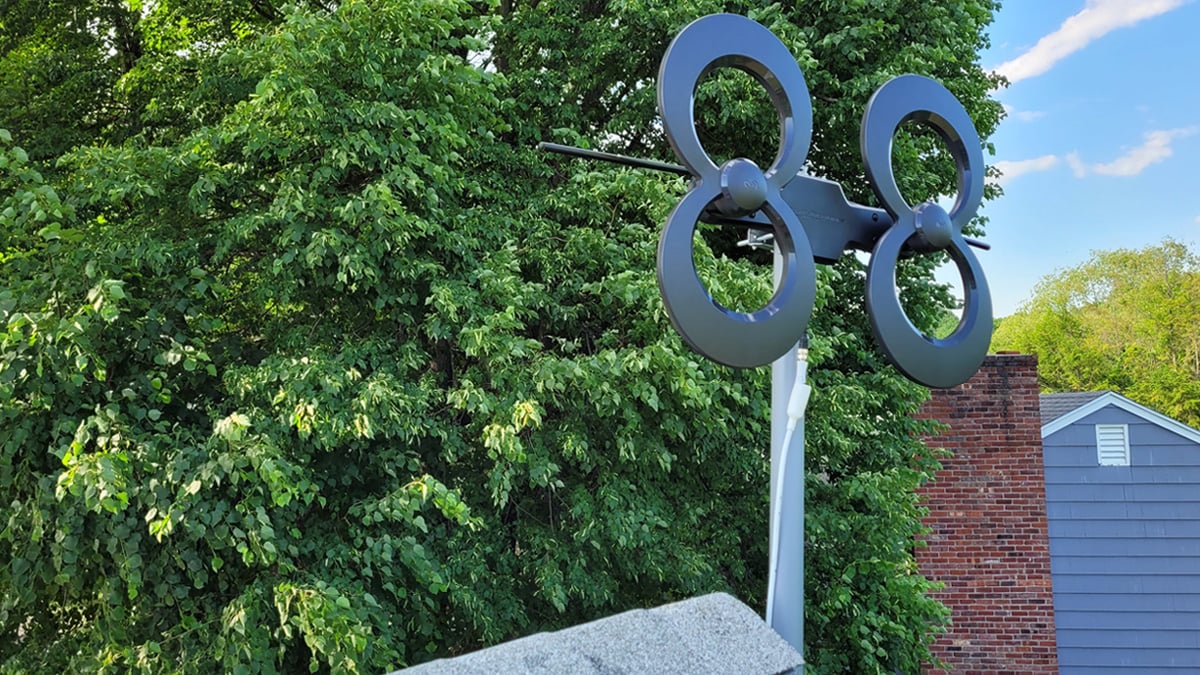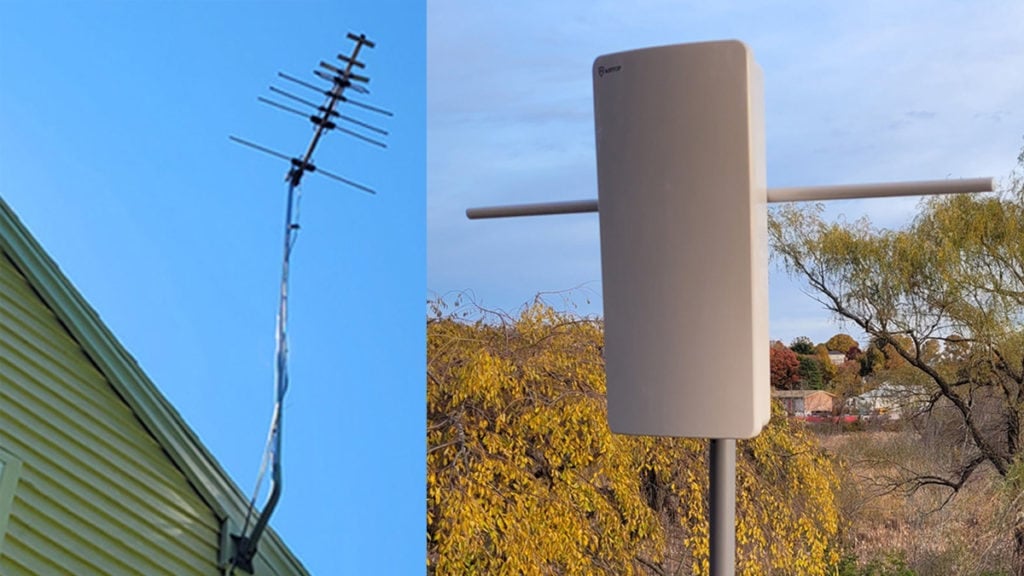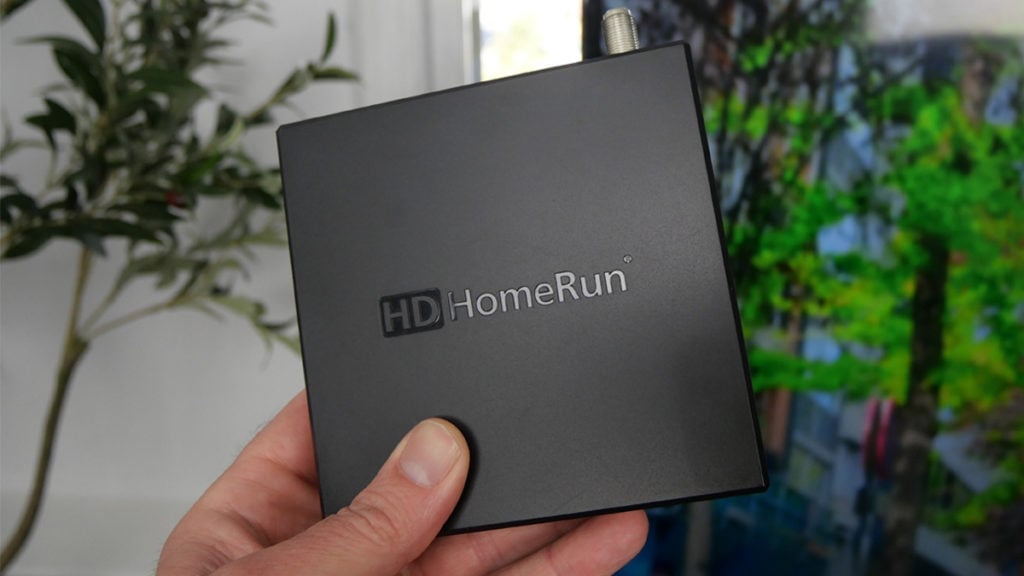Published on: May 16, 2023
Last Updated: December 30, 2023
TV antennas can get free local channels on any Smart TV, or even an older non-Smart TV. Butting getting the best reception from local broadcasters is another story for some.
- How to get more channels with an antenna
- Locate Your Broadcast Towers
- Are your stations UHF or VHF?
- Elevate with an antenna pole
- Check your coaxial cable
- Keep coaxial cable away from electric wires
- Antenna Preamplifier
- Splitters can weaken signal
- TV signal meter
- 5G, 4G LTE Filter
- FM Trap or FM Filters
- Mount in attic or outside
- Virtual Channels vs Real Channels
- Ignore marketing jargon
- Try different antenna
Millions of cord-cutters are already relying on a TV antenna to get broadcast networks such as ABC, NBC, CBS, FOX, and PBS for free. Popular sub-channels such as MeTV and ionTV could be in your broadcast area as well.
You shouldn’t get discouraged if your first channel scan yields less than stellar results. It is important to figure out up front whether you are using the best indoor TV antenna, or best outdoor TV antenna for your location.
A great TV antenna still may encounter some level of interference or problems with getting TV signals in your area.
How to get more channels with an antenna
Before you start shopping for more equipment, or even different antennas, you should try these 16 fixes for better TV reception.
Some people incorrectly assume that adding an amplifier will always improve picture resolution. In reality, an amplifier can sometimes make reception worse.
Before diving into various fixes, let’s cover some basics.
Forget about all the TV antennas advertised as having a 100-mile or 250-mile range. It’s not happening.
Why you can trust The Cord Cutting Report: I do hands-on testing with TV-related products and services throughout the year. Find out more about the review policy.
You shouldn’t expect to get a TV station from over 55 miles away even with an outdoor TV antenna. Based on my years of installing outdoor TV antennas, mounting them on roofs and inside of attics, I can one thing about range with certainty.
Getting a digital TV signal from more than 50 miles away is more the exception than the rule.
Indoor antennas can get TV signals from 25 or 30 miles away under ideal circumstances.
Digital TV signals travel in a straight, line-of-sight direction and diminish quickly. They do not bounce off other objects, or travel along the curve of the Earth.
During the analog TV era, you may get a faint TV signal from very far away. With digital TV signals, either you get the channel, or you don’t.
Locate Your Broadcast Towers
Forget about range. Know your distance.
The so-called “range” of outdoor antennas and indoor antennas can often be a red herring when it comes to getting better reception. Too many companies over-promise on range of antennas.
But it is important to know how far local broadcast towers are from your house or apartment building. You should likewise take note of whether your antenna is facing in the general direction of local broadcast towers.
The Federal Communications Commission has a free tool called DTV Reception Maps that gives a detailed breakdown of how likely you can get a specific TV channel. Just type in your zip code or address to get started.
Each TV station is rated as “strong”, “moderate”, “weak” or “No signal” based on your specific location. Click on the TV station’s call sign to see detailed information about a specific TV station.
TV signals that are rated “strong” or “moderate” should be available to you with the correct antenna setup. An outdoor TV antenna might even get you some TV signals ranked “weak.”
The Antennas Direct Transmitter Locator tool estimates distance from individual towers, and even recommends whether you need an indoor antenna or outdoor antenna.
Interested in NextGen TV (ATSC 3.0) for your area? Check out rabbitears.info for NextGen TV broadcasters. Just remember you will need a NextGen TV or NextGen TV tuner for to get ATSC 3.0 signals.
Are your stations UHF or VHF?
DTV Reception Maps and Antennas Direct Transmitter Locator can tell you whether local TV stations are broadcasting on the UHF or VHF band.
Most stations in the U.S. use the UHF band, but not all of them.
Having VHF elements are key to getting TV stations that broadcast on the VHF band. What does a VHF element look like? Usually it is one or more horizontal rod that you can find on various models of outdoor multidirectional antennas and directional antennas.

Since digital signals replaced analog TV in 2009, most TV stations have been using the UHF band. But large markets, such as Los Angeles, have a number of important broadcasters still using the lower-frequency or Hi-VHF band.
When NextGen TV becomes the new norm for broadcasters, TV stations will be on the UHF band.
Elevate with an antenna pole
Elevating your TV antenna as high as possible can make a big difference with getting better reception of over-the-air channels.
Raise an indoor TV antenna on a wall closer to the ceiling, or even better, raise it near a window facing the general direction of local broadcast towers.
If you need to raise an outdoor antenna, consider an antenna pole or mast.
Antenna poles can be especially useful for getting a TV signal from a tower that is 40 or 50 miles away, but might be hindered from obstructions such as trees or hilly terrain. That was exactly the situation I was dealing with a few years back when I was setting up a directional antenna on a relative’s home in Southern Maine.

Channel Master makes a heavy duty five foot antenna pole. It is a stackable pole, so you can add another five feet if needed.
Sometimes a longer mount adds enough height. I use a Winegard 38-inch mast for my outdoor antenna. A short mast can be useful for mounting a bigger antenna model inside of an attic.
Check your coaxial cable
You should inspect your coaxial cable closely regardless of whether you have a long or short run of cord. Make sure it has no breaks or severe bends.
If your coaxial cable looks questionable, especially if it’s a longer run, it might be worth replacing. Many antennas come with RG59 cable. Some antenna installers recommend RG6 because it is thicker and more durable.
Keep coaxial cable away from electric wires
Wiring behind a television can sometimes look like a jumbled mess. Streaming devices, DVRs and game consoles all have their own electrical cords and HDMI connections to a TV.
You should make sure your coaxial cable run from that connects your TV to the antenna does not paralell any electric wires. Having a parallel run of wires can interfere with TV signals.
If you discover that your coaxial cable was running along the same path as other electrical wires, move them and then do rescan for channels under your TV settings.
Antenna Preamplifier
An outdoor antenna may have a weak TV signal because of the length of cable that is connected to the TV.
Antennas lose a little bit of signal strength with every foot of a long cable run. It doesn’t matter if your antenna is mounted to a roof or inside an attic.
An antenna preamplifier (sometimes called a signal booster) adds gain at the antenna to prevent signal loss that comes from a longer cable run. The signal booster typically comes in two parts. The amp is located at the antenna. The inserter sends power from an electrical outlet through the cable.

Some outdoor antennas such as the Antop 800SBS come with an antenna preamplifier that allows you to adjust the gain with a dial.
If you live in an area where you have strong signals, your long cable run probably won’t be much of a problem. Adding an preamplifier or signal booster can actually lead creating more interference.
Antenna preamplifiers will not add new channels to your lineup. Preamplifiers are not the same as a distribution amp.
FURTHER READING: Antop AT-800SBS outdoor antenna review
Splitters can weaken signal
Even a simple, unpowered a two-way antenna splitter can turn a good picture into an unwatchable one. There is an easy way to determine whether a splitter is impacting your picture reception.
Remove the splitter, connect the antenna to one TV and do a channel scan to see if you have better reception. If you really need to get OTA channels to multiple TVs in your house, you have two options to mitigate bad reception.
Distribution amplifiers
You can replace a splitter with distribution amplifiers that compensate for loss of signal strength when a cable run is split by adding a some gain. Distribution amplifiers are one piece that is used indoors, and should help you overcome TV signal loss from a splitter.
TV tuner or OTA DVR
A TV tuner or OTA DVR is a great way to get free OTA channels to multiple TVs with a minimal cable run. HDHomeRun and Tablo DVRs makes live over-the-air channels available across your Wi-Fi network.
Once you connect a TV antenna to a TV tuner from HDHomeRun or Tablo, you can watch OTA channels on a TV, smartphone, tablet or game console.

HDHomeRun and Tablo units also function as a DVR. These TV tuners can either plug in to a number of hard drives for storing recordings. Some models include internal storage.
Antenna placement is a key factor in getting the best reception possible.
Connecting a TV antenna to a TV tuner or OTA DVR instead of a TV can help you with optimal antenna placement.
TV signal meter
See if your Smart TV has a built-in signal meter. A signal meter can help you fine tune the direction you are pointing your TV antenna.
Many Smart TVs and even older non-Smart TVs have a signal meter under the settings tab. You want to look under the channel section, or option where you scan for channels. Look for a section called “Signal Strength,” “Signal Meter”, “Antenna” or “DTV Signal.”
You can buy a TV signal meter. A digital converter box is a better buy for the same money.
You can get an Ematic AT103B digital converter box which shows a percentage of signal you have. A TV signal meter is a great tool when you are fine tuning your exact antenna placement.
5G, 4G LTE Filter
5G and LTE signals can cause some interference with OTA signals on the UHF band. At the moment, there is not any overlap with the TV spectrum, but if you live near close to a cell tower, you may want to investigate whether it is interfering with your UHF reception.
Channels 32 through 36 are the closest to 5G and LTE signals. Adding a 5G / LTE filter can dampen any noise that is bleeding into your TV signal.
Antenna manufacturers such as Antennas Direct, Channel Master, and Antop all make LTE filters that dampen mobile phone signals.
FM Trap or FM Filters
Nearby FM radio stations can interfere with VHF reception.
FM radio band is next to the low-VHF band spectrum. The low VHF TV spectrum (channels 2 through 6) runs 54-88 MHz. FM Radio stations are on 88-108 MHz.
FM signals can bleed into TV signals, especially for anyone living within 10 miles of an FM radio station. Larger FM stations transmit powerful signals, and can impact weaker TV signals on the lower VHF band.
TV antennas are very good at picking up FM stations.
Some antennas have built-in FM traps. If you have eliminated other potential issues such as interfering 4G or 5G LTE mobile signals, you may want to try an FM Filter or FM Trap.
You can attach one to your coaxial, and do a channel scan. Channel Master makes an in-line FM Filter (CM-3202). The company makes the Titan 2 Preamplifier, which has an FM trap and LTE Filter as well.
If your local TV stations are on the UHF band, then interference from a local FM tower will not be an issue.
Mount in attic or outside
An indoor antenna may not get you the number of channels or a clear TV signal in your area, especially if are living in a rural area or outside of a large city.
Elevation will always improve your chances of better reception. Having an outdoor TV antenna mounted inside an attic or on a roof can really help with getting more OTA channels.
If you do install a TV antenna in your attic, be sure you keep your lines away from electrical wires. Make sure to ground your antenna properly. Consult a local professional if you don’t know how.
Virtual Channels vs Real Channels
This might be obvious, but you should know where your actual TV channel should actually be in your channel guide.
Just because your local NBC station identifies itself as “NBC 10”, it doesn’t mean that is where you will find it in your channel lineup.
Local TV stations identify themselves with a “virtual channel” that sometimes dates back to their analog TV days. But their real channel number is different.
Knowing the difference between real and virtual channel numbers should eliminate any confusion about the channels you are trying to watch.
Ignore marketing jargon
Finding the best TV antenna for your location can get confusing thanks to a ton of marketing jargon. Be wary of any antenna that boasts a 100-mile range or more.
A TV antenna is optimized for UHF, VHF or both. There is no such thing as a specific model for HD reception, 4K reception, 8K reception, and so on.
Not only should you avoid any model claiming an outrageous range of 100 miles or more. You can ignore terms such as HD antenna, HDTV antenna, digital antenna, 4K antenna, 8K antenna, etc.
In most of the U.S., the broadcast standard in your area is ATSC 1.0, which has picture resolution up to 720p or 1080i. You may live in a market that has both ATSC 1.0, and NextGen TV (ATSC 3.0).
NextGen TV can broadcast up to 4K picture resolution, but some markets have only upgraded to a 1080p resolution. You don’t need a specific antenna for NextGen TV, but you will need either a Smart TV with a NextGen TV tuner.
If you live in a market that has made the transition to NextGen TV, don’t worry. TV stations will be maintaining their current ATSC 1.0 signals for at least the next five years.
Try different antenna
If all of the free fixes mentioned in this guide don’t improve your picture, or add channels that you should able to get, it might be time to shop around for a different antenna.
Generally speaking, an outdoor antenna on a roof or in an attic will always outperform an indoor antenna. Elevation and direction of an antenna can help you the most with getting better reception.
A larger, directional antenna can help with faraway stations more than a multi-directional antenna.
Shop around with the major brands. Antennas Direct, Antop, Channel Master, Mohu, Winegard, and Televes are among the major TV antenna makers with an established record for quality and performance.
For more news on streaming, how-to guides and reviews, head over to the main page of The Cord Cutting Report or follow the CCR on Google News.
